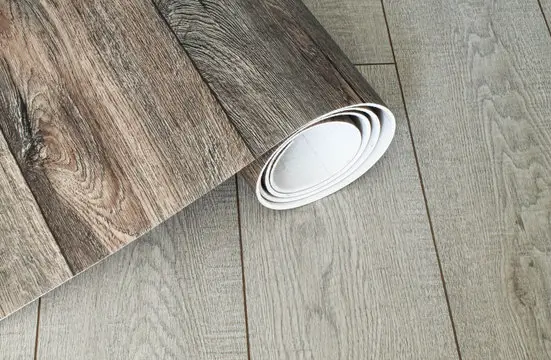Roll flooring is one of the most popular and cost-effective options for homeowners looking to upgrade their interior living spaces. It’s easy to install, low maintenance, and extremely versatile. Let’s take a look at what roll flooring is and why it might be a great option for your home.
What is Roll Flooring?
Roll flooring is exactly what it sounds like it comes in large rolls that are easy to install. It can be used in any room in your home, including kitchens, bathrooms, basements, and bedrooms.
This type of flooring is available in a variety of colors, styles, textures, and patterns, so you can find something perfect for your space.
Benefits of Roll Flooring
The biggest benefit of roll flooring is that it’s incredibly cost-efficient compared to other types of flooring. It also requires very little maintenance just regular vacuuming or sweeping to keep it clean.
And since it comes in large rolls, installation is quick and easy. You won’t have to worry about cutting individual pieces of wood or tile for your floors!
Plus, since roll flooring is so versatile and comes in such a wide range of colors and styles, you can easily customize your space with something unique that reflects your personal taste!
Durability
Another great thing about roll flooring is its durability; it stands up well against wear and tears thanks to its strong construction materials. It can also handle heavy foot traffic without showing signs of wear or damage over time.
Additionally, certain types of roll flooring are waterproof and resistant to scratches or dents perfect if you have pets or kids running around!
Related Topic: What is LTB Flooring? Facts You Should Know!
Is Rolled Vinyl Flooring Good?

Rolled vinyl flooring is an affordable option that has been gaining popularity among homeowners. It is easy to install, it’s often waterproof, and it comes in a variety of colors, textures, and styles.
But there are also some drawbacks of rolled vinyl flooring that should be taken into consideration before you decide if it’s right for your home. Let’s take a closer look at the pros and cons of rolled vinyl flooring.
Pros of Rolled Vinyl Flooring
The biggest advantage of rolled vinyl flooring is its affordability. It typically costs less than other types of flooring such as tile or hardwood, yet still provides a great look without sacrificing quality.
Additionally, it is relatively easy to install and most people can do the job themselves with minimal tools and experience. And since it’s made from synthetic materials, it is waterproof and therefore easier to clean than traditional carpets or rugs.
Moreover, rolled vinyl comes in a variety of colors and styles so you can find the perfect match for your home decor.
Cons of Rolled Vinyl Flooring
Like any type of flooring material, rolled vinyl has its drawbacks as well. One common complaint about this type of flooring is that it can feel cold underfoot since there isn’t much cushion between your feet and the ground below.
This can be an issue during winter months when temperatures drop significantly indoors.
Additionally, some people complain that it doesn’t last as long as other types of floors due to wear and tear over time caused by foot traffic and furniture movement.
This means you may need to replace your floors sooner than expected if you choose rolled vinyl flooring for your home.
Finally, although rolled vinyl is available in a variety of styles, they may not be as visually appealing as other types such as tile or hardwood so if looks are important to you then you’ll want to consider other options before making a decision about which type of flooring to install in your home.
Conclusion
Rolled vinyl flooring is an affordable option that offers many benefits for homeowners looking for an easy-to-install solution for their homes.
However, there are some drawbacks that should be taken into consideration before deciding if this type of flooring material is the best choice for your needs from cold feet during winter months to limited visual appeal compared to other types so make sure you weigh all these factors carefully before making a final decision about what kind of flooring material to choose for your home!
Related Topic: Do It Yourself Tile Flooring? Tile Flooring Installation
Bottom Line
Roll flooring has become increasingly popular over the years due to its affordability, versatility, low maintenance requirements, and ease of installation.
Whether you’re looking for something classic or modern for your home’s interior design scheme, there’s sure to be a type of roll flooring that fits the bill perfectly!
If you want an affordable yet durable way to upgrade your living space without spending too much money or time on installation then roll flooring might just be the ideal solution for you!
FAQs
What is the most popular flooring in homes today?
Carpet is the most popular flooring choice for homes today. It provides a comfortable feel and adds warmth to any space. It also comes in a wide variety of colors, textures, and fabrics.
Additionally, carpets can insulate sound, making them an ideal choice for people who prefer quieter spaces inside their homes.
What is the cheapest flooring method?
Laminate flooring is one of the most cost-effective options for new flooring. It mimics the look and feel of hardwood floors at a fraction of the cost, is easily installed, and requires minimal maintenance.
Laminate is also durable and comes in many colors, patterns, and styles so you can get a unique look without breaking the bank.
Does vinyl roll flooring need underlayment?
To ensure its longevity and performance, it should always be installed with an underlayment. This helps to create a flat base while delivering noise reduction benefits, increased durability, and extra cushion underfoot.
Investing in an appropriate underlayment before laying your vinyl roll flooring is essential for creating the perfect finish you desire.
What flooring does not require underlayment?
Laminate flooring and luxury vinyl tile are two popular types of flooring that do not require underlayment for installation. Both of these materials are composed of multiple layers that, when installed, create a cushioned walking surface.
One benefit of skipping the underlayment step is shorter installation times and cost savings. Plus, without additional padding, these floors snap together and lay flat on their own!


2 thoughts on “What is Roll Flooring? Advantages & Disadvanatges”